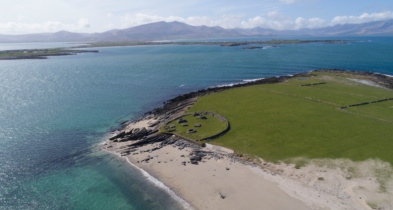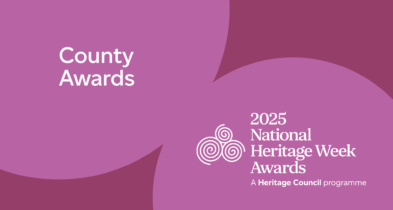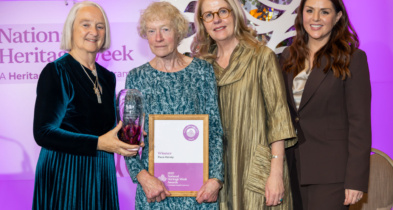
Sharing your heritage project on social media

Great, you’ve decided on your heritage project idea, you’ve completed your research and you’re ready to share your project. You can submit your completed heritage project through our project submission form in the project organisers portal on the National Heritage Week website. But first you have to share it with the world.
Depending on the type of project you are working on, you might be thinking about using social media to present your heritage project and share it with your audience.
To get you started, we have selected three social media platforms that you could use to share your project with the National Heritage Week team, your community and the wider public. All of the platforms showcased here are free and easy to use. Explore the pros and cons of each and find the perfect fit for you and your heritage project.
Facebook is widely used, user-friendly, and is a great platform for building an online community and engaging local people. It is the most popular social media platform on the internet and will work well for you if your heritage project is a photo exhibition or accompanied by photos or images, or if you plan on sharing videos with your audience. It will also allow you to tell stories and accompany your visual content with descriptions. We would recommend you keep your posts to 100-150 words, to make your content reader-friendly. To help to engage your audience, it is also worth thinking about how to give your followers a reason to comment on your posts: ask questions; invite feedback; use previous comments as the inspiration for new posts.
The Facebook Live feature is very useful if you are organising an online event and want to broadcast it on the internet, and save it as a recording to be shared widely afterwards.
If your project includes a small socially-distanced gathering or heritage walk, you can promote it on Facebook by creating an ‘event’ connected to your project’s main page. Please adhere to the prevailing Government guidelines with regard to mass gatherings and COVID-19 when planning your event.
For most heritage projects, the best way to use Facebook to capture your project is to create a Facebook page for your heritage project. There are a number of ways to set up a Facebook page – you can a) set up a new account; b) link it to your organisation’s account (if appropriate), or c) link it to your personal account. The benefits of using an existing account are that you will receive notifications from your project page when you sign-in to the account and you will have an existing online community that you can promote your project to by ‘inviting’ your connections to like your project page.
If you, or your organisation, do not have an account, you can set up a new one and use your project as a way of building an online community. To do so, log on to Facebook and follow the instructions.
Visit www.facebook.com for more details.
If you are specifically trying to connect with a younger audience, it might be worth considering sharing your heritage project on Instagram. This is the fastest-growing social media platform, with the majority of users under 30 years of age.
Instagram is all about images. If your project is made up on photographs, images or graphics, it is worth considering Instagram as the social media platform to promote your heritage project. Like Facebook, you can share images, videos and text with your followers.
To share your project on Instagram, create an Instagram account for your heritage project and upload your images to it. If your organisation is already active on Instagram, you can post from this account and use a designated hashtag so that your audience can follow your project. You will find more on hashtags below.
For Instagram, it might be worth considering a strategic approach to how and when you share your content. Depending on your project, it might work well to gradually share your images so that you can take your followers on a heritage journey over the duration of National Heritage Week, or you might consider using the ‘story’ function to allow you to share your images for a short period of time in a sequence, so that viewers can travel through them like a picture book.
Depending on the demographic of your target audience, Instagram might be a good fit for you. But a word of warning: your content will need to be powerful and compelling to ensure audience engagement on this fast-moving platform.
Check out www.instagram.com for more details.
You might also want to consider Twitter when you are weighing up your options for social media. When it comes to sharing content, Twitter is unlike either Facebook or Instagram. The value of Twitter is its brevity: the length of each tweet is capped at 280 characters.
If you are considering using Twitter, think about the audience you want to engage and the type of content you want to share. Because of its brevity and fast-pace, Twitter is likely not suitable to host your project, but it can be a really good tool to promote it, by attracting users to your website / blog, YouTube channel or podcast, and to remind your audience of project updates or top-line research findings. If you’re new to Twitter, you’ll need to build your followers for greatest impact. You can do this by identifying key influencers in your project topic area (e.g. heritage experts or other project organisers) and following them; following your target audience; retweeting relevant users’ content; sharing compelling content (including images and video), and using hashtags to create a following.
A hashtag is a word or phrase with a # at the start e.g. #HeritageWeek. They are used on social media to identify messages on a specific topic and, as they’re searchable, they act like a compass to help us to navigate social media content so that we can find the type of posts we are interested in. It is worth thinking about your audience and others interested in your topic and the hashtags they might use to look for your project. Do you need to create a new hashtag that is unique for your heritage project? Should you use existing hashtags already popular in your heritage area e.g. #Genealogy? Or, could you use both? Whatever your strategy, make sure you add your hashtags to each piece you post on social media to ensure maximum exposure. If you’re planning on using a ‘unique’ hashtag, always check what has previously been shared under that hashtag to ensure your project in not associated with another campaign.
To join the online community of project organisers for National Heritage Week 2020, include some of our existing hashtags or use them to search other projects being organised.
Popular hashtags across all social media channels for National Heritage Week 2020 are: #NationalHeritageWeek #HeritageWeek2020 #HeritageAndEducation #HeritageOnYourDoorstep #RelearningSkillsFromOurHeritage.
Check out www.twitter.com for more details.
Other tools:
As you consider how social media might help you to share your heritage project, it is worth exploring some other tools that are out there to support you as you go about compiling and presenting your content and findings.
1. Canva
Canva is a graphic design tool that allows you to create and design graphics, presentations, posters and other visual content. It is worth exploring if you are working on events that need invitations or posters, infographics, social media posts, or if you just want to give your presentation a more professional look. If your project is lacking original photographs or images, you can choose from Canva’s impressive selection of stock photos to add a new dimension to your work, for example a stock photo of a sheep might help you tell your heritage story on the importance wool once played for local industry in your area. Canva is easy to use and the free version will allow you to create impressive creations to bring your project to life.
Check out www.canva.com for more details.
2. Medium
Medium is an online publishing platform that will allow you to create and share your heritage project as a blog. If you think your project would work well on its own website but don’t have the expertise to create a full site, Medium might be the option for you.
You can easily input your research, images and videos into Medium and build compelling blog posts around them. You might then link your blog posts from Medium to other social media platforms where your community will find them.
By using Medium, you will be joining an online community where you can find other blogs covering similar topics. Add tags (similar to hashtags) to your posts to make them easily searchable so that other Medium users can find them. Check out www.medium.com
for more details.

